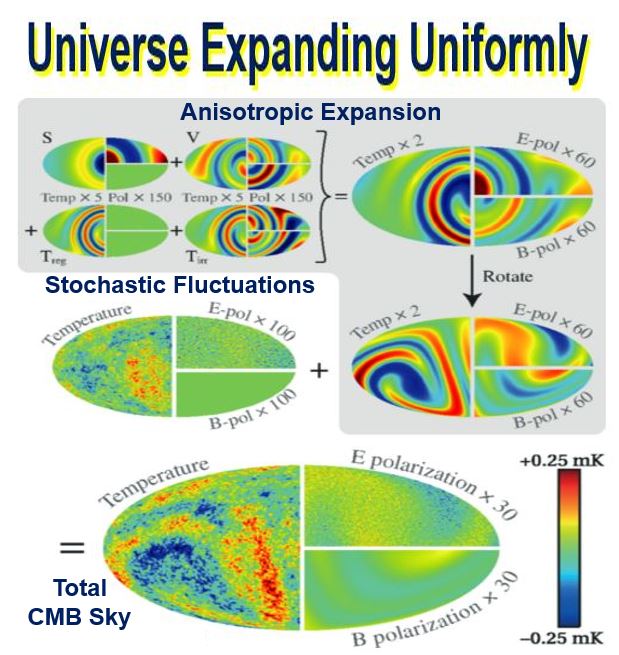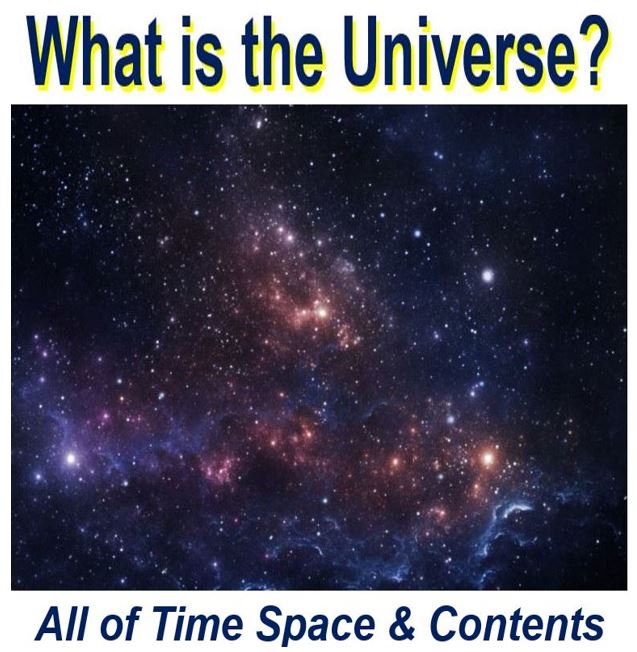The Universe has no direction, it is not spinning or being stretched in any particular direction, and is expanding uniformly, says a team of scientists at University College London and Imperial College London.
If we gaze into the night sky, we see a clumpy Universe – planets orbit their stars in solar systems, which are grouped into galaxies, which in turn form gigantic galaxy clusters.
However, cosmologists (they study the Universe’s physical form) assume that this effect is just local – if we view things in a sufficiently large enough scale, it is, in fact, all uniform.
The Universe is everything. It consists of all space, time, planets, stars, other celestial bodies, and galaxies. It also includes all matter and energy that exists anywhere.
 Maps were produced using the oldest light there is out there – Cosmic Microwave Radiation. Several tests were performed. The scientists concluded that our Universe is not being stretched in different directions and is not spinning – it is expanding uniformly. (Image: journals.aps.org)
Maps were produced using the oldest light there is out there – Cosmic Microwave Radiation. Several tests were performed. The scientists concluded that our Universe is not being stretched in different directions and is not spinning – it is expanding uniformly. (Image: journals.aps.org)
Virtually every calculation made about the Universe begins with this assumption – that it is broadly the same, whatever direction you look or position you take.
If one part of the Universe were being stretched, or if the whole thing were being pulled out in one direction, or rotating about an axis in a similar way our planet does, this fundamental assumption, and all our calculations that hinge on it, would be completely wrong.
The London scientists explained in the journal Physical Review Letters (citation below) that they put this assumption through its most rigorous test yet, and have concluded that there is just a 1 in 121,000 probability that all that exists out there is not uniform, i.e. not the same in all directions.
Oldest light in our Universe
To do this, Dr. Stephen Feeney, from the Department of Physics at Imperial College London, PhD student Daniela Saadeh at University College London, and colleagues used maps of the CMB (cosmic microwave background) radiation – the thermal radiation left over from the time of recombination in Big Bang cosmology, i.e. the oldest light there is out there.
How Isotropic is the Universe? #cosmology https://t.co/DReDksgbZq https://t.co/D2Lp8U0Vvm pic.twitter.com/FGckew5fsA
— Physical Review Lett (@PhysRevLett) September 21, 2016
The maps were produced using CMB data taken by the European Space Agency’s Planck satellite between 2009 and 2013. It provided a picture of the intensity, and for the first time ever, polarization (essentially the orientation) of the CMB across the entire sky.
If everything out there were spinning about an axis, it would create spiral patterns. A Universe expanding at varying speeds along different axes would create elongated cold and hot spots.
The scientists searched for these patterns in the observed CMB and found that none were a match, and that the Universe’s direction is almost definitely uniform, i.e. it is directionless.
It’s the same in every direction
Regarding this latest study and the team’s conclusions, Dr. Feeney said:
“This work is important because it tests one of the fundamental assumptions on which almost all cosmological calculations are based: that the universe is the same in every direction. If this assumption is wrong, and our universe spins or stretches in one direction more than another, we’d have to rethink our basic picture of the universe.”
“We have put this assumption to its most exacting examination yet, testing for a huge variety of spinning and stretching universes that have never been considered before. When we compare these predictions to the Planck satellite’s latest measurements, we find overwhelming evidence that the universe is the same in all directions.”
 The Universe is all of time, space and its contents. It includes living things, planets, solar systems, stars, dust clouds, galaxies, and light. Before it was born, time, space and matter did not exist, scientists say. (Image: imperial.ac.uk)
The Universe is all of time, space and its contents. It includes living things, planets, solar systems, stars, dust clouds, galaxies, and light. Before it was born, time, space and matter did not exist, scientists say. (Image: imperial.ac.uk)
Lead author, Ms. Saadeh, added:
“You can never rule it out completely, but we now calculate the odds that the universe prefers one direction over another at just 1 in 121,000. We’re very glad that our work vindicates what most cosmologists assume. For now, cosmology is safe.”
The work was supported by the Engineering Physical Sciences Research Council, the Perren Fund, the Royal Astronomical Society, the IMPACT fund, the Science and Technology Facilities Council, the Royal Society, and the European Research Council.
In an Abstract preceding the main paper in the journal, the authors concluded:
“Including all degrees of freedom simultaneously for the first time, anisotropic expansion of the Universe is strongly disfavored, with odds of 121,000:1 against.”
Citaion: “How isotropic is the Universe?” D. Saadeh, S. M. Feeney, A. Pontzen, H. V. Peiris and J. D. McEwen. Physical Review Letters 117, 131302. Published 21 September 2016. DOI: 10.1103/PhysRevLett.117.131302.
